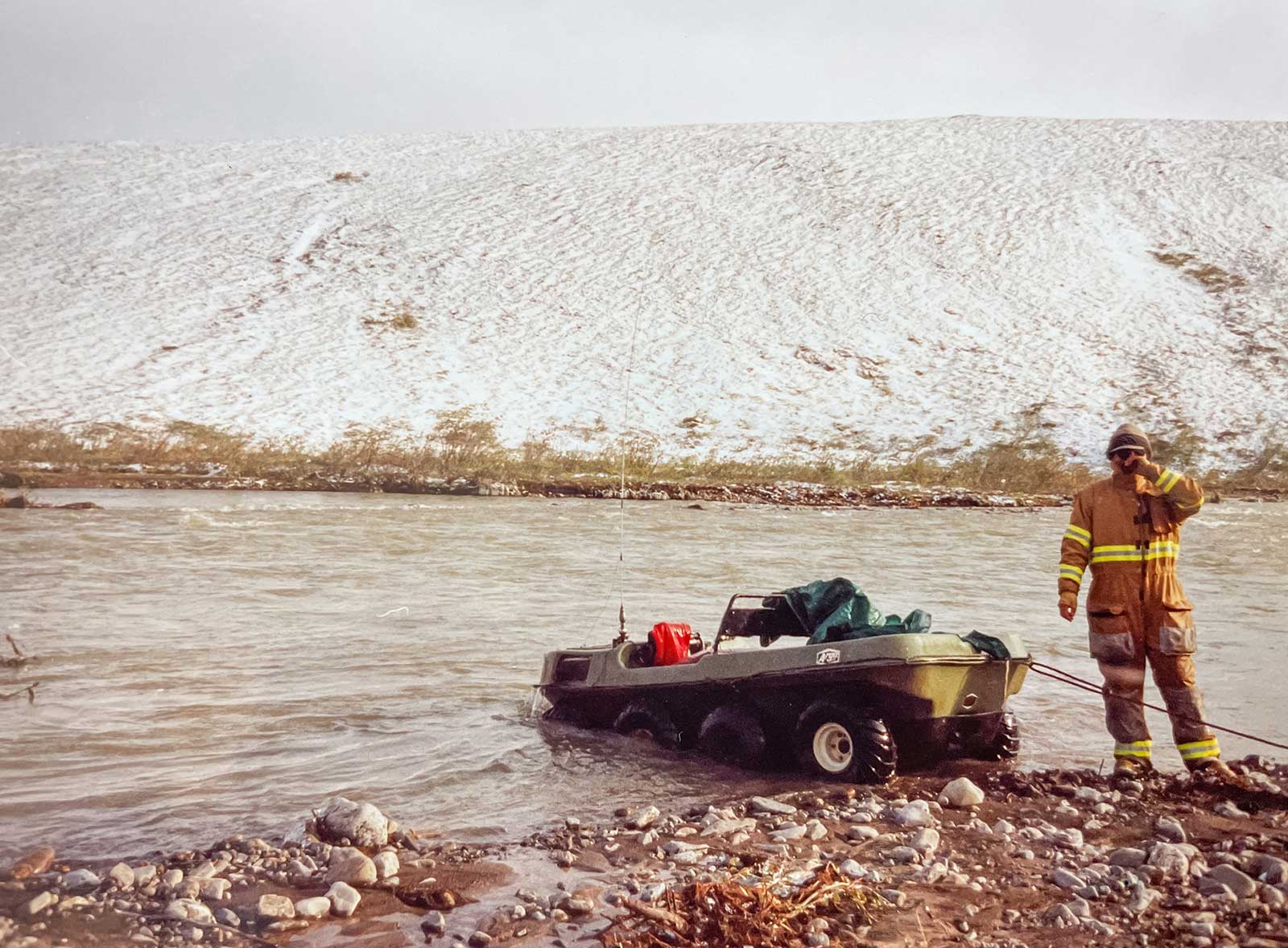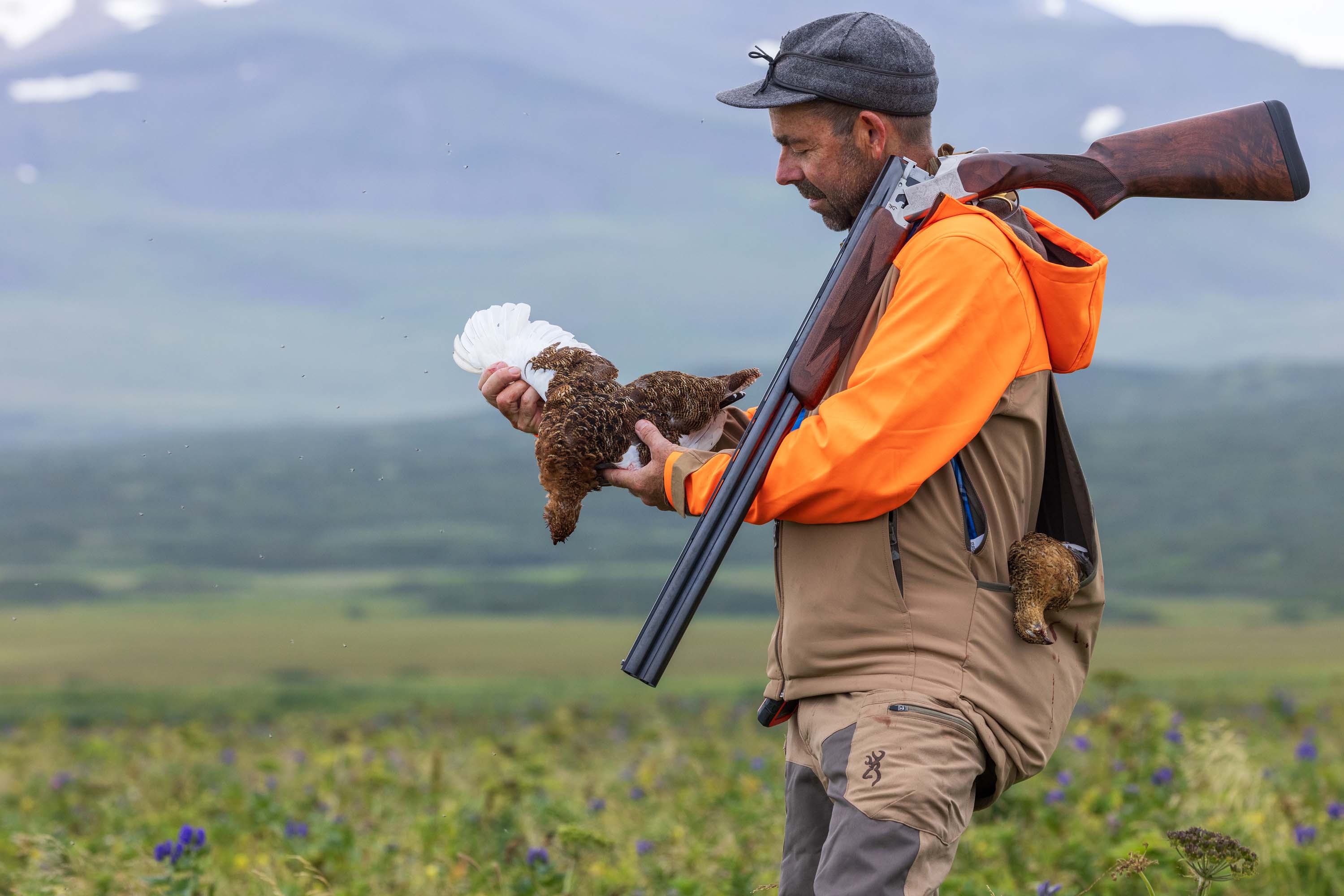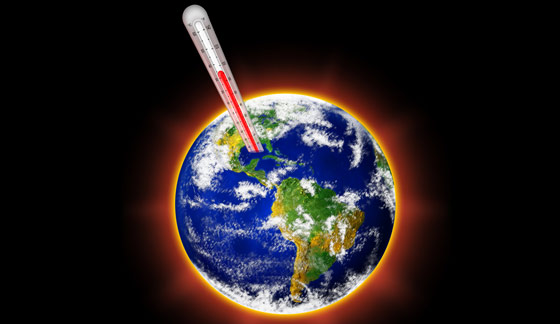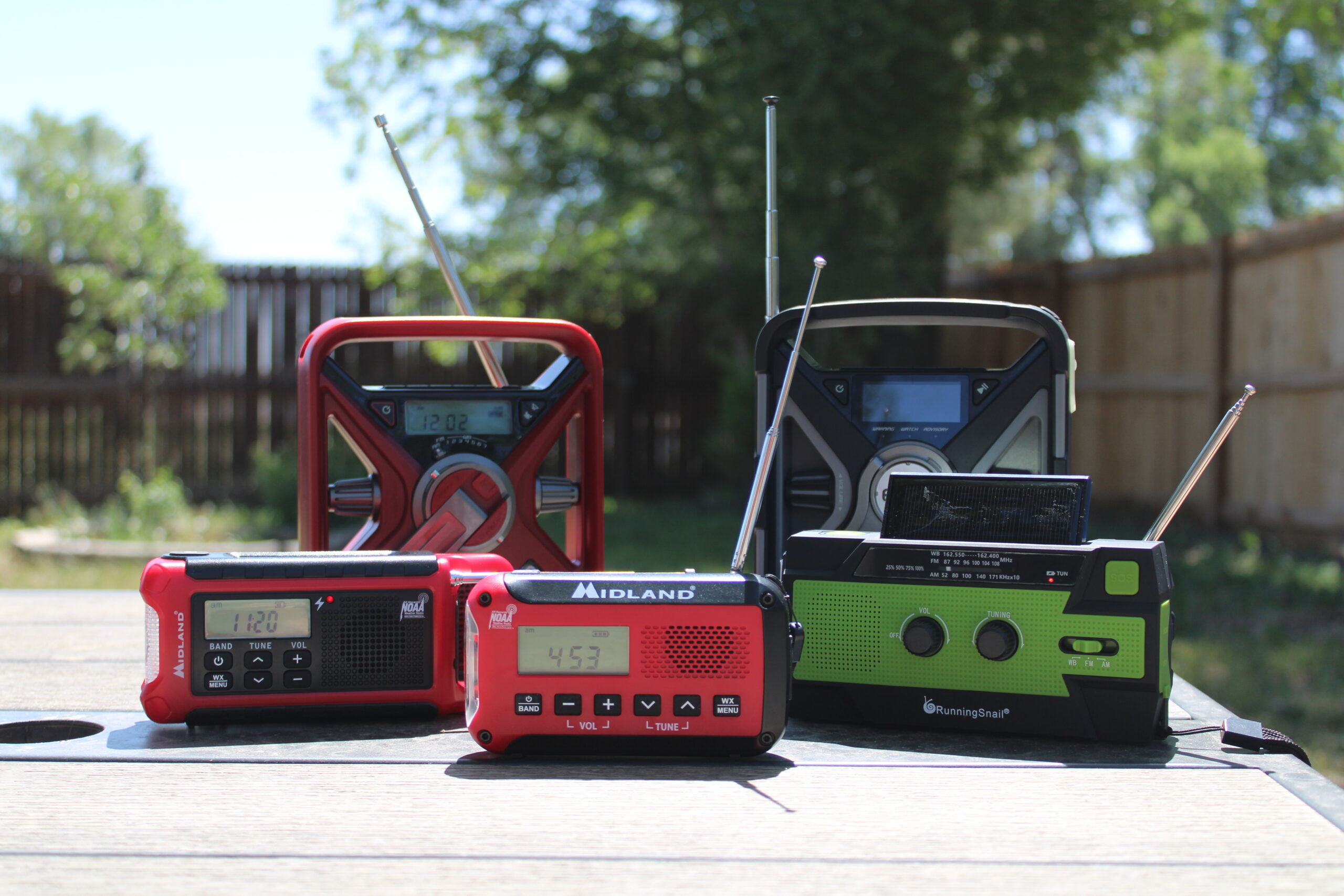I Nearly Froze to Death When Our Argo Sank in the Middle of an Arctic River

The numbness in my feet had made its way up both legs and now I could no longer feel my calf muscles. After 15 minutes of standing in the glacial waters of the Kalutagiaq River I had to make a decision; wait for possible help or ford the swift, chest-deep river.
Along with the chilling water, I had to contend with 30 mph winds, blowing snow, and 24 degree temperatures. With the sun slipping behind Alaska’s towering Brooks Range, temperatures would quickly drop into the low teens. I couldn’t stand the pain in my legs any longer.
I knew I had to try swimming to shore, fast. If I stayed where I was any longer — knee deep on a gravel bar amid a fast-flowing river — I would surely freeze to death. Of course the potential of cramping muscles also entered my mind, which would mean sure death by drowning.
I found myself in this predicament while hunting Dall sheep, moose, and caribou with my good friend and life-long North Slope resident Ben Hopson, Jr. The now late Hopson was a Native Inupiat man who grew up in the village of Wainwright before moving to Anaktuvuk Pass, where we both lived at the time. My wife and I were school teachers in this village on Alaska’s North Slope, just over 250 miles north of Fairbanks.
Hopson was one of the most knowledgeable men I’d ever met when it came to Arctic survival, hunting, and trapping. The outdoors was a part of Hopson’s culture for many generations, and he was most happy when he was out exploring new territory in the challenging Arctic conditions. He had a sixth sense that was fascinating to witness in the wild, and added to his level of confidence and fearlessness.
Throughout my time in Alaska in the mid-1990s, I had the good fortune to hunt and trap with Hopson on numerous occasions. I spent more time in the wilderness with him than anyone else when I lived in the Pass, and I will be forever grateful for all he taught me about the Arctic. On more than one occasion I entrusted Hopson with my life.
High Hopes and Argo Troubles
But, on this 23rd day of August 1994, our plans were not turning out as anticipated. With three inches of fresh snow on the valley floor, there was not yet enough powder to break out the snow machines. Instead, we took Hopson’s Argo. The all-terrain, amphibious, eight-wheel vehicle is an important mode of transportation for the people of Anaktuvuk Pass.
I have been in Argos that have climbed up and down hillsides that were so steep it felt like the machine was going to flip over at any moment. I’ve crossed creeks and rivers where water has flowed into the cab, but the machines always just kept going. The amphibious vessel even has a place for an outboard motor, making the maneuverability much more efficient in deep water instead of depending only on the fat paddle-treaded tires. But on this river crossing, we had no outboard motor.
Our August day began as a good one. Hopson and I traveled 11 miles south of Anaktuvuk Pass to a point where we could see thousands of acres. We glassed several mountainsides and one creek drainage along with the John River. Picking up no sign after an hour, we moved south into the Kalutagiaq River drainage in search of moose browsing in the willows.
After starting the machine we moved only a few feet before a throttle cable broke. We came up with a makeshift contraption where I reached across Hopson and worked the cable while he steered. Argos don’t have a steering wheel per se; instead, they have two levers you pull back and push forward, much like the steering on a Caterpillar tractor. We bounced about the topless Argo and practically gave each other concussions with every bump we hit. That’s when we stopped and Hopson used his CB to radio the village. Within all Arctic villages — as in most villages throughout the Last Frontier — CB radios were the foremost source of communication. On this day it proved a lifesaver.
Miraculously, someone from the village heard us as they prepared to head our direction in search of caribou. Two hours later we had a new cable. It was mid-afternoon, and the party who dropped off our cable continued south to Masu Creek.
Hopson and I went over a few more knolls, glassing for caribou. With no luck, we too, headed south toward Masu Creek, a big drainage known to hold moose and caribou. As we neared the Kalutagiaq River, Hopson commented on how high it was. I’d never seen this part of it. We had been getting an unusual amount of rain and snow that month, and the increased runoff led to high water levels in all of the valleys. Approaching the river, the Argo died on us. It just quit running, 50 yards from the river bank. Hopson started it up, seemingly not too concerned about the mishap. We crawled to river’s edge and surveyed the rapids with the engine idling. Again, the Argo died. I was concerned at this point and my confidence in the machine was diminishing quickly.
Hopson mumbled something about how the Argo had never behaved like this. He started it up again and turned along the bank to where a trail led to the river. A big lump formed in my throat. I had never crossed a river of this magnitude in an Argo.
Sending It
After much discussion, Hopson decided to attempt a crossing. The heavy silt of the glacial river prevented us from seeing the bottom, so we had no idea how deep it was. Even if we had to float a distance, we figured we could maintain our momentum and reach the other side of the river as long as we kept the paddle-treaded balloon tires moving. Hopson eased the front end of the Argo into the river. There was no turning back now.
Immediately the current tugged at us, whipping our front end straight downstream. It was deep enough that we weren’t touching bottom and we began floating downriver — not across, as planned. Right when Hopson started making headway in getting the Argo straightened out, the engine died. We drifted out of control. We had no oars. I could see a huge, partially submerged root wad looming from the river bank 40 yards downstream; we were headed right for it. After floating out of control for 25 yards, our tires finally found gravel. We figured we were safe and could ease our way up the submerged gravel bar we had floated onto. Soon we discovered we were not resting on a gravel bar, but were high-centered on a big rock in the middle of the river. After several attempts, Hopson got the machine started. Our efforts to move forward were futile as the wheels just spun with nothing to dig into. Realizing the predicament we faced, we began rocking the Argo from side to side. As the machine bobbed up and down, a wave caught the front end, kicking us loose.
Again, we were on the move and out of control. Again, the engine died. The root wad downstream grew larger as we swept right for it. Knowing we had to get by the root wad, or face getting tangled in it and inevitably sinking, I crawled on to the front of the Argo while Hopson moved to the back to maintain our balance. Advancing at such a high speed, I realized we had too much momentum built up for us to alter the course of the half-ton machine. I reached out as far past the hood as I could, trying to keep us from getting entangled in the gnarled heap. I grabbed the closest root and shoved with all my might. It wasn’t enough. The left front end caught the root wad, spun us 180 degrees, slamming us into the rest of the mass. Instantly we began taking on water over every edge.
Ben grabbed gear as it floated away. I lunged for my rifle, my late grandfather’s Winchester pre-1964 Model 70 .30-06 that I received when I turned 12. Then I grabbed the CB. Seeing that the radio was submerging in water, and fearing it would short out at any moment, I yelled for help.
I shouted into the CB microphone,“This is Ben and Scott, we’re sinking in the river! We are…”
Tcchhhhhhh. As I held the microphone in my hand yelling for help, static came from the receiver as the unit shorted out. Whether anyone heard us, we did not know. We were now on our own, sinking, and being carried downstream out of control. The current began forcing us back into the middle of the river. I grabbed my pack as other odds and ends floated out of the Argo, carried away downstream.
We fought to maintain our balance. Traveling another 40 yards out of control, the tires finally settled on the bottom. Though we were now in only three and a half feet of water, we were far from safe, as the swiftness of the river was overpowering.
With the Argo totally submerged, Ben and I stood knee deep in the glacial water. Our feet facing downstream so water could be kept out of our boots’ eyelets as long as possible. We collected our thoughts.
The Crossing
I’d lost my gloves to the river, and all of our extra clothes were soaked. We lost our food, a tarp, some cushions, and a few other minor items. Coming to rest at the widest portion of the stream, smack in the middle of the river, was not good. We still had another 30 yards to go to reach the river bank opposite from where we had entered. This meant if we could successfully get to the bank, we would now be on the opposite side of the river from the village. Crossing over to the village side of the river was impossible as it was too deep and too swift. We also knew that nighttime temperatures would be reaching single digits.
Knowing we would have to make a move soon, Hopson elected to take his pack and try wading the river to get a fire going.
Easing into the stream, Hopson began shuffling across the swift current to the bank. Underestimating the power of the raging river, Hopson struggled with all his might to keep his balance. The water slammed into his six-foot-one frame and curled around his chest, creating a wall of water that made it difficult for me to even see anything but his head. Miraculously, he made it to the other side, his legs wobbling from the strain of fighting the current and frigid water. While he walked around the gravel bar trying to improve his circulation and regain some coordination, I began feeling the numbness making its way up my calves. I would soon have to make a decision.
I had my rifle, pack, and another bag of assorted items. Hopson knew I could not make it with such a load as the current was simply too powerful. He shouted as loud as he could, and I could barely hear him over the roaring river. He informed me he was going to try making his way back to me and help carry the rest of our gear to shore. Less than half way to me the rapids became too strong and Hopson was forced to retreat to the gravel bar. My legs were numb. I knew I had to make a move.
Glancing around the area one last time, a flash of light atop a knoll caught my eye, one mile downriver from where I stood. The setting sun managed to cast light through the cloud-choked sky, and I miraculously happened to glance in the right direction at the right moment as it reflected off the windshield of an oncoming Argo. I hollered to Hopson but he couldn’t see the vehicle from where he stood. I shouted that I had spotted an Argo and would try staying where I was until it arrived. Five slow minutes passed. I had been in the water for over 15 minutes. The numbness in my legs turned to a throbbing, aching pain as I prayed the Argo would appear soon.
The Rescue Crew
I was overjoyed when I saw the Argo burst through the willows, 50 yards behind Hopson. Cause for still more elation was the fact I spotted a winch on their front end. It’s a good thing I was able to remain in the river as long as I did, because now I could attach their winch to our sunken machine.
Our rescuers, Jimmy Jack and Raymond Paneak, began unreeling cable as Hopson grabbed the end of the line and waded my way. Ten yards from me was all the closer Hopson could get. Gathering a bunch of slack cable in his hand, Hopson whirled the hooked end around in the air and let it fly. I caught it, instantly kneeled on the back of the Argo, reached underneath and attached the hook to the frame. Water slapped my head and torso and rushed into my jacket. I was soaking wet but adrenaline kept me going. With the cable firmly secured and Hopson back on the bank, they started towing me in.
Not knowing if the winch could handle the weight of the Argo and the force of the rampaging river, I held on, hoping to feel movement. The cable grew taught and the Argo slowly crept toward safety. Turning my back so as not to catch the end of the cable in the face should it snap, I felt like a circus acrobat struggling to maintain my balance. WAs the Argo emerged from the river, water poured out from everywhere. Once on dry land we let the Argo continue draining and Hopson and I joined Raymond beside a fire he’d built.
It was now after 6 p.m and 12 degrees. We stripped off our ice-covered clothes, boots, and socks and hung them on willow branches around the fire to dry. We huddled around the blaze and slurped hot coffee. The warmth of the fire stung at first, but the coffee was a comfort I’ll never forget. Gazing at burning embers of fire as they spiraled into thin air, we felt safe, and the fear of hypothermia eventually dissipated. As we stood around the fire, Jimmy and Raymond told us how they heard my distress call on the CB and how we got cut off in mid-sentence. They turned around immediately and headed our way. Fortunately for us, they were still in CB range.
Ten minutes later another Argo arrived. Riley Morry and Roosevelt Paneak had also heard our cries for help and had been following the river trying to find us.
Our Argo, it was completely covered in ice, already an inch thick in places. Within 30 minutes our clothes were dried and we slithered back into them. We did all we could to thaw out the Argo. We chipped away ice on the outside with large river rocks. Placing several round river rocks in the fire, they turned red-hot. Then we carefully placed them in the hull to try melting the ice-entombed engine.
While waiting for the engine to thaw we investigated the machine. After much inspection, Hopson discovered a clump of squirrel hair that had made its way into the fuel line and clogged it. Squirrel hair, of all things. How it got in there was beyond us.
Homecoming
For over an hour we tried to thaw the frozen Argo but to no avail. It was simply too cold and the ice too thick. It was getting late and we figured it best to leave the Argo behind and start home. Traveling a quarter-mile upstream, we safely crossed the river and arrived back in the village shortly after 2 a.m. On our way home we radioed Hopson’s wife, Dorothy, who called my wife, Tiffany, and told her what had happened and that we were okay. As had happened so many times before, I was greeted at the door by my lovely wife and a plate of hot food.
We came home empty handed, but most importantly, Hopson and I returned alive. Had we been forced to spend the night in those frigid conditions, who knows what the outcome would have been.
With temperatures still above freezing during the day, it wouldn’t take long for the Argo to thaw. Thanks to a decrease in snow and rainfall the river level dropped to the point where crossing it was safe. A few days later Hopson and a couple other men made the 15-mile ride back to his Argo. Though they couldn’t get it running, they were able to tow it back to the village. Once the Argo was cleaned up, Hopson and I were back on the hunt, as we needed meat for winter. This time, we were a little more cautious about our river crossings.
Note: For personally signed copies of Scott Haugen’s best selling book, Hunting The Alaskan High Arctic, visit scotthaugen.com
Read the full article here







